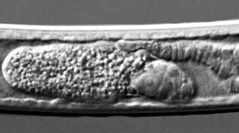

 European Journal of Taxonomy
857 (1) - Pages 1-56
European Journal of Taxonomy
857 (1) - Pages 1-56Six new and four known species of the genus Axonchium Cobb, 1920 are described and illustrated from the Western Ghats of India. Axonchium indicum sp. nov. has a 1.2–1.4 mm long body, offset lip region, 8–9 µm long odontostyle, expanded part of pharynx 39–49 % of total neck length, anterior uterine sac 0.9–1.6 times the mid-body diameter long, and a bluntly conoid tail. Axonchium microspiculum sp. nov. has a 1.1–1.22 mm long body, offset lip region, 7–8 µm long odontostyle, 20–23 µm long spicules, two weakly developed ventromedian supplements, and obtusely rounded tail. Axonchium nilgiriense sp. nov. has a 1.4–1.6 mm long body, offset lip region, 8–9 µm long odontostyle, vagina strongly bent posteriad, 37–41 µm long spicules, 3–4 ventromedian supplements, and bluntly conoid tail. Axonchium paracingulatum sp. nov. has a 2.5–2.8 mm long body, offset lip region, 10–11 µm long odontostyle, vaginal lumen highly expanded in the middle, 69 µm long spicules, and broadly conoid tail with rounded terminus. Axonchium tropicum sp. nov. has a 1.7–2.0 mm long body, offset lip region, 11–12 µm long odontostyle, anterior uterine sac 2.3–4.0 times the mid-body diameter long, 40 µm long spicules, 4 widely spaced ventromedian supplements, and broadly rounded tail. Axonchium uniqum sp. nov. has a 1.7–2.0 mm long body, offset lip region, 10–11 µm long odontostyle, anterior uterine sac 2.5–2.8 times mid-body diameter long, 68 µm long and slender spicules, and broadly conoid tail. Axonchium nitidum, A. saccatum, A. transkeiense and A. vallum are redescribed based on specimens collected from several localities. A diagnostic key to the identification of the valid species of this genus is provided.